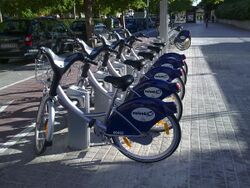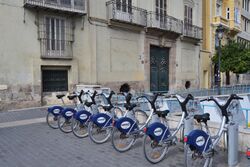Engineering:Valenbisi
 | |
 Valenbisi station and bikes in Valencia. | |
| Overview | |
|---|---|
| Owner | Ajuntament de Valencia (municipality) |
| Locale | Valencia |
| Transit type | Bicycle sharing system |
| Number of stations | 275 (2014)[1] |
| Daily ridership | 13,305 (2014)[1] |
| Annual ridership | 6,081,733 (until October 2014)[1] |
| Website | www.valenbisi.es |
| Operation | |
| Began operation | June 21, 2010 |
| Operator(s) | JCDecaux |
| Number of vehicles | 2.750[1] |
Valenbisi is the name of a bicycle sharing system in Valencia inaugurated on June 21, 2010. It is similar to the Vélo'v service in Lyon or Vélib' in Paris, and using the same bicycles and stations as used in Dublin, Vienna, and Brussels. Its purpose is to cover the small and medium daily routes within the city in a climate-friendly way, eliminating the pollution, roadway noise, and traffic congestion that motor vehicles create.
Operation
The city council and JCDecaux manage and maintain the system. To use it, users must acquire a yearly membership. Currently the network consists of more than 275 stations to lend and return over 2750 bicycles distributed throughout the system.[1] The stations are situated through most of the flat areas of the city with a distance of around 300 to 400 metres between each one, with many situated next to public transport stops to allow for intermodal use. Metro Stations usually have signs pointing to the locations of nearest Valenbisi stations. The bikes can be lent from, and returned to, any station in the system, making it suitable for one-way travel. Each station has between 15 and 30 parking slots to fix and lock bicycles, but in highly transited areas many stations may be close together.
Subscription
Use of the system is based on membership, and users can subscribe online or by visiting a service office. The Valenbisi member cards are only sent to addresses in Valencia in an attempt to prevent tourists from using the system.[2]
Stations
Bike stations have generally replaced on-street car or motorcycle parking spaces, though others were placed on large pedestrian areas. Each station includes a long series of docks for bikes, with a computerized pylon at one end for completing transactions.
Financing
The system is paid for mostly by local car drivers with an on-street parking control system, distributed throughout much of the densely populated inner city. This money, about €1 million annually, is paid to the system operator. The yearly user fee is €29,12.
See also
Sources
- ↑ 1.0 1.1 1.2 1.3 1.4 "Valenbisi information about the system". Valenbisi. http://www.valenbisi.es/Funcionamiento/Puntos-de-recogida-y-entrega. Retrieved 5 November 2014.
- ↑ http://www.valenbisi.es/Abonate


